Welcome to the fascinating world of birds in San Gabriel! This area is great for observing and learning about various birds, from the common house sparrow to the majestic bald eagle.
With its diverse habitats, from wetlands and oak woodlands to grasslands and chaparral, San Gabriel is a great place to spot various birds, from songbirds to raptors.
Whether you are a beginner or an experienced birder, there is something for everyone.
From novice birders to experts, there are plenty of opportunities to observe, identify, and enjoy San Gabriel’s avian residents. So grab your binoculars and join us on a journey through the wonders of San Gabriel’s birds.
23 Birds to Watch in San Gabriel
San Gabriel Valley in Southern California offers a diverse range of bird species for enthusiasts to observe. Here’s a list of 23 birds commonly found in the San Gabriel Valley:
1. Red-Tailed Hawk
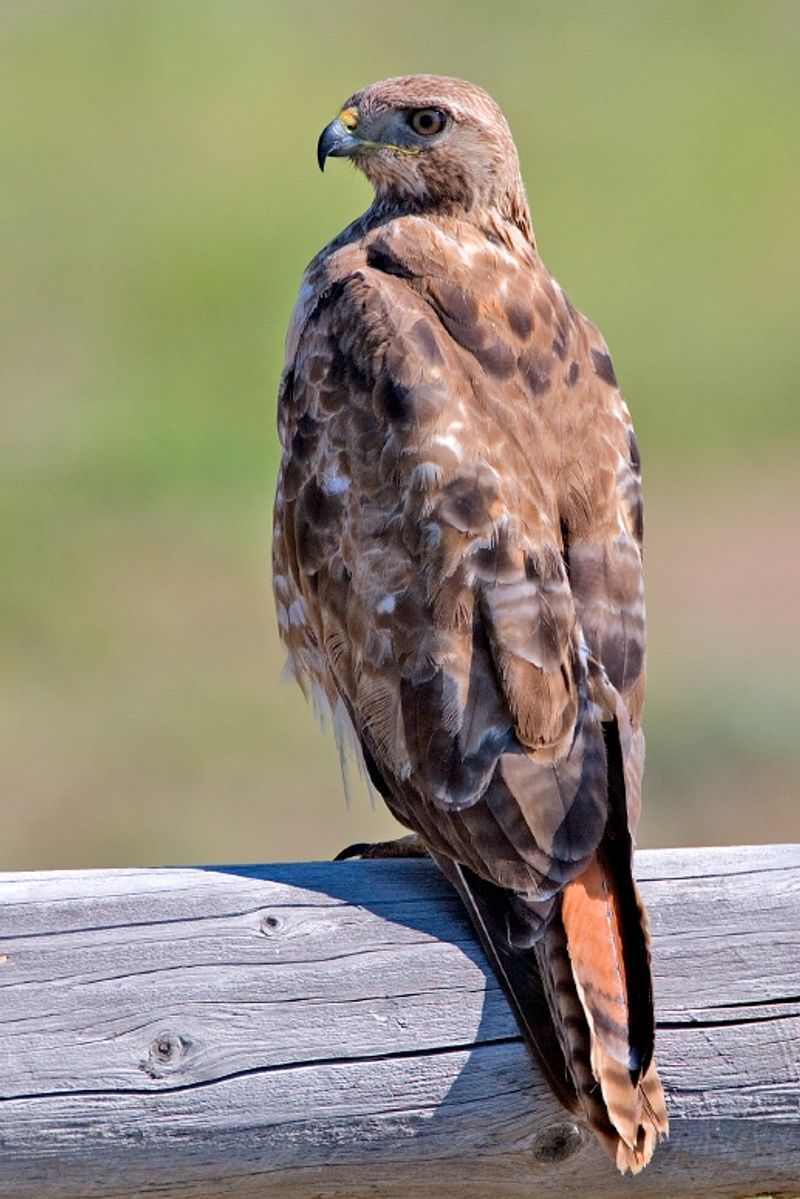
The red-tailed hawk is a bird of prey in North America. It has a large geographic range stretches from the interior of Alaska and northern Canada down to Panama and the West Indies.
It is a member of the Buteo genus, a genus of eagles, hawks, and buzzards found in a variety of habitats across the world. Red-tailed hawks are one of North America’s most common birds in the Buteo genus.
They typically live in open areas such as grasslands, deserts, and savannas. These birds feed mainly on small mammals like mice and voles but also eat insects, reptiles, and other birds. Red-tailed hawks have a unique call often heard echoing through the skies.
They are known for soaring high in the air, utilizing their exceptional eyesight to spot prey from a distance. These birds strongly bond with their mates, often remaining together for life.
Red-tailed hawks are important members of the avian community in North America, playing a vital role in the environment.
| Kingdom | Animalia |
| Phylum | Chordata |
| Class | Aves |
| Order | Accipitriformes |
| Family | Accipitridae |
| Genus | Buteo |
| Species | B. jamaicensis |
2. White-Crowned Sparrow
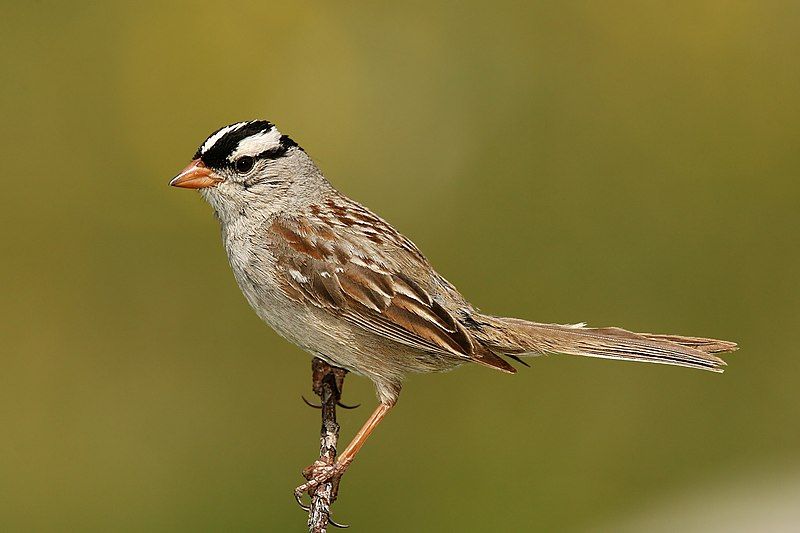
The white-crowned sparrow is a species of bird native to North America and belongs to the New World sparrow family. It is a medium-sized bird with a grey face and black and white streaks on its upper head.
The bird is easily recognizable due to its unique coloring and markings. The white-crowned sparrow is a common sight in North America and can be found in open woodlands, parks, and residential areas. They are active daily and feed on insects, seeds, and berries.
The white-crowned sparrow is a migratory species and will travel long distances during the winter months to reach warmer climates. They are also known to form large flocks when migrating, making them a spectacular sight in the sky.
The white-crowned sparrow is a beautiful bird that is a joy to observe in its natural habitat.
| Kingdom | Animalia |
| Phylum | Chordata |
| Class | Aves |
| Order | Passeriformes |
| Family | Passerellidae |
| Genus | Zonotrichia |
| Species | Z. leucophrys |
3. Yellow-Rumped Warbler
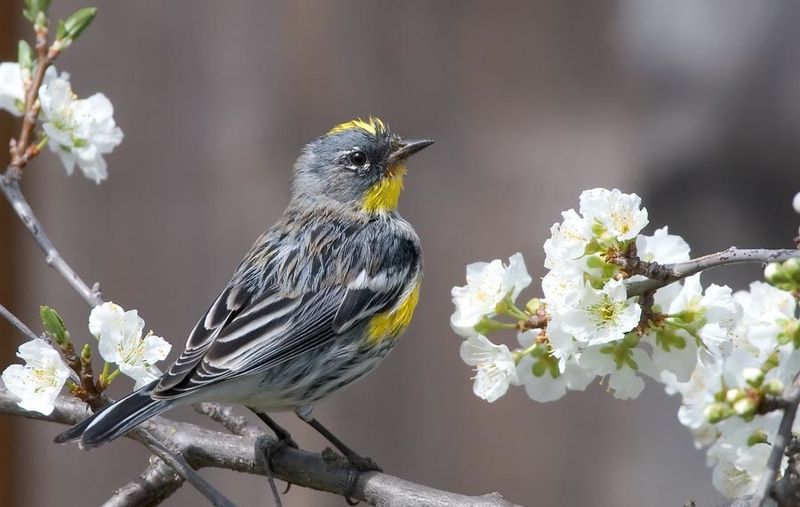
The yellow-rumped warbler is a migratory bird species throughout much of North America. It has a distinct yellow patch on its lower back, which is how it gets its name.
This species is widely distributed and can be found in various habitats, from deciduous forests to grasslands to wetlands. It is a common sight during the spring and fall migration seasons when it can be seen flitting from tree to tree and foraging for insects.
It is one of the earliest birds to arrive in the spring and one of the last to leave in the fall. It is an important part of the North American avian landscape and is a welcome sight for many bird watchers.
| Kingdom | Animalia |
| Phylum | Chordata |
| Class | Aves |
| Order | Passeriformes |
| Family | Parulidae |
| Genus | Setophaga |
| Species | S. coronata |
4. White-Winged Dove
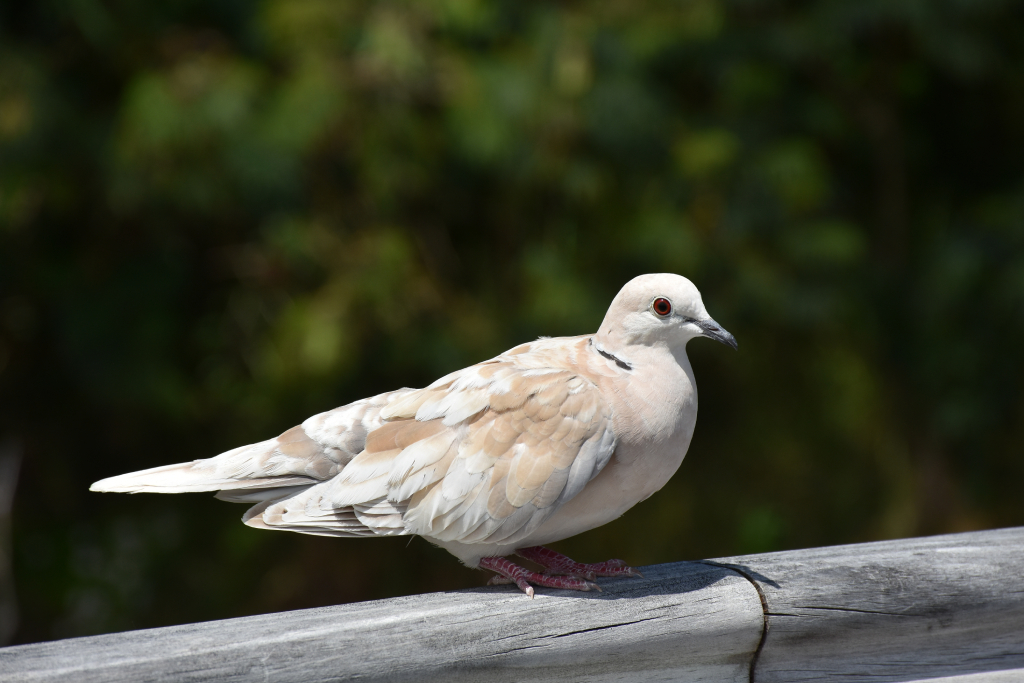
The white-winged dove is a species native to the Southwestern United States, Mexico, Central America, and the Caribbean. Its unique white wing markings make it a relatively large bird and can be easily distinguished from other doves.
They have blue eyering around the eyes and bright red eyes. The white-winged dove symbolizes peace and tranquility and is a sight when in flight. The white-winged dove can be found in various habitats, from open grasslands to thick forests.
They are especially fond of areas near water, where they can search for food and build nests. The white-winged dove is an important species in its native range, and its presence signifies a healthy ecosystem.
| Kingdom | Animalia |
| Phylum | Chordata |
| Class | Aves |
| Order | Columbiformes |
| Family | Columbidae |
| Genus | Zenaida |
| Species | Z. asiatica |
5. California Scrub Jay
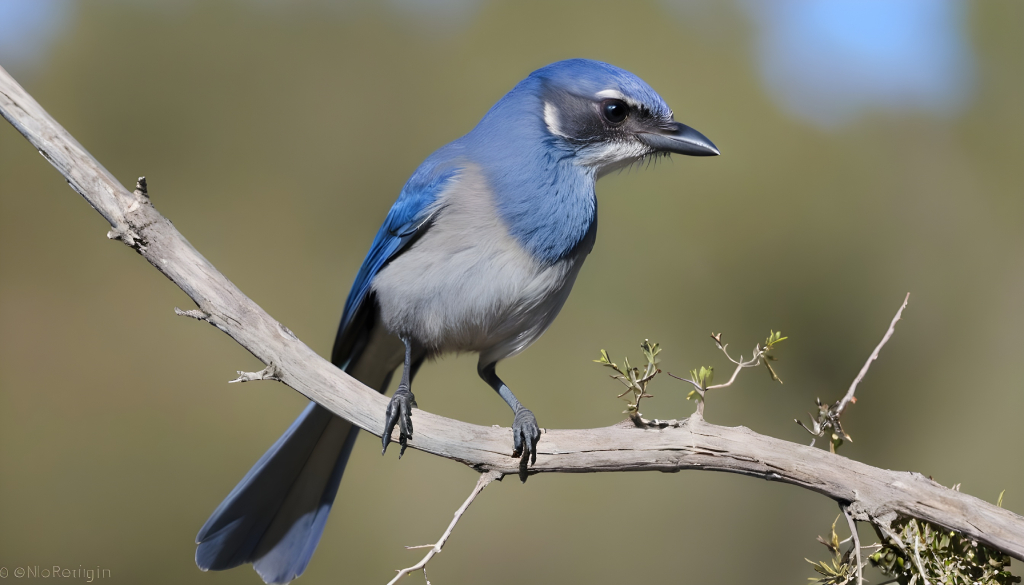
The California scrub jay is a bird species native to western North America. This bird is found in a wide range of habitats, from the forests of British Columbia to the Sierra Nevada mountain range. It is also found in California and western Nevada near Reno.
This bird is a scrub jay known for its curious and bold behavior. They have a unique blue and gray coloring, which makes them easily recognizable. They are also known for their calls, which are pretty loud and often heard over long distances.
They are also known for their intelligence, which is documented in several studies. The California scrub jay is an important species that helps to maintain the balance of the ecosystem in western North America.
| Kingdom | Animalia |
| Phylum | Chordata |
| Class | Aves |
| Order | Passeriformes |
| Family | Corvidae |
| Genus | Aphelocoma |
| Species | A. californica |
6. Western Bluebird
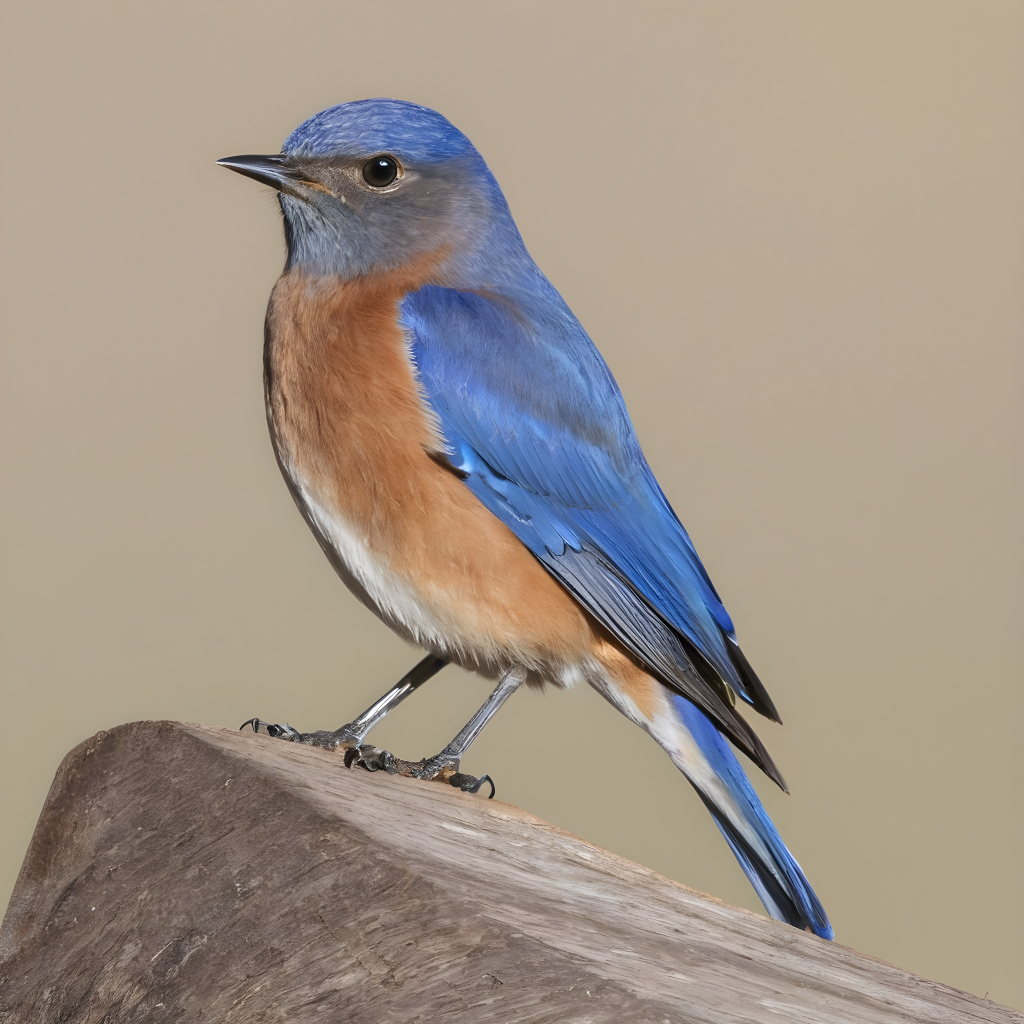
The western bluebird is a small, colorful bird native to North America. It belongs to the thrush family, which includes other birds such as the American robin and the very.
The western bluebird is found across much of the western United States and Canada, ranging from Alaska to Arizona and California to the Great Plains.
It prefers open habitats with plenty of shrubs and trees and is often seen perched atop fence posts and other tall objects.
The western bluebird is a medium-sized bird, measuring 7 and 8.5 inches long and weighing about one ounce. Its body is mostly a bright blue, with a reddish-brown breast and a white belly. Its bill is black, and its legs are gray.
Its tail is short and rounded, and its wings are slightly pointed. The male and female western bluebirds are very similar in appearance, although the male tends to be slightly brighter in color. The western bluebird feeds mainly on insects, berries, and other small invertebrates.
It forages on the ground and also hovers in the air to catch food. It will also occasionally visit bird feeders. During the breeding season, the western bluebird builds a cup-shaped nest out of twigs and grasses.
It lays three to five eggs that are pale blue or greenish. In addition to its attractive appearance, the western bluebird is also known for its melodic song. Its song is a mix of warbles, trills, and whistles and often includes mimicry of other birds.
While the western bluebird is not currently threatened, its population has declined in recent years due to habitat loss and human disturbance. However, its range is still quite large, and it can still be found in many parts of western North America.
| Kingdom | Animalia |
| Phylum | Chordata |
| Class | Aves |
| Order | Passeriformes |
| Family | Turdidae |
| Genus | Sialia |
| Species | S. mexicana |
7. Mourning Dove
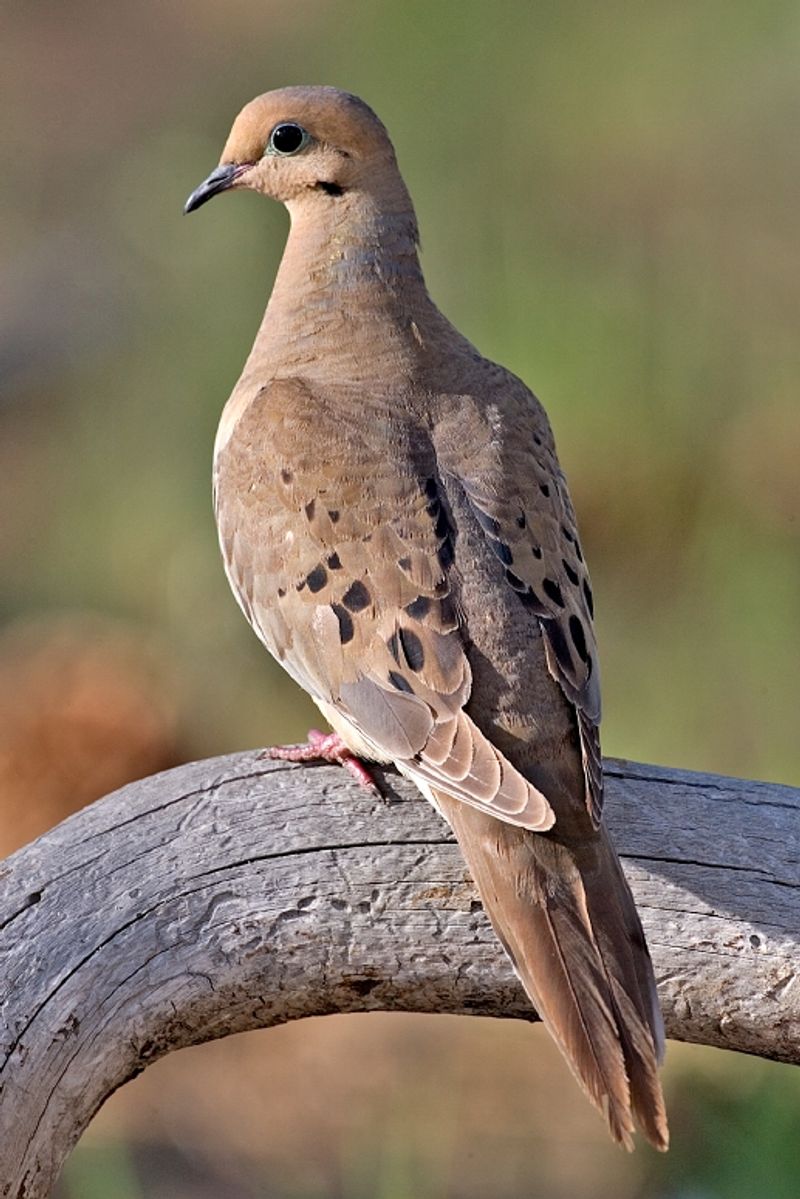
The mourning dove is a species of bird in the Columbidae family, which includes other doves and pigeons. It is also known as the American mourning dove, the rain dove, and colloquially as the turtle dove.
Historically, the mourning dove has also been called the Carolina pigeon and Carolina turtledove. It is a medium-sized bird with a gray-brown body and a white-tipped tail. Its wings are pointed, and its bill is short and black.
Mourning doves have a distinctive call: a soft, mournful cooing sound. They are found throughout North America and are common in open woodlands, farmland, and suburban areas. Mourning doves build flimsy nests of twigs and grasses, feeding mostly on seeds.
They are monogamous and will often form long-term pair bonds. They are also known to migrate in the fall and winter months.
| Kingdom | Animalia |
| Phylum | Chordata |
| Class | Aves |
| Order | Columbiformes |
| Family | Columbidae |
| Genus | Zenaida |
| Species | Z. macroura |
8. Acorn Woodpecker
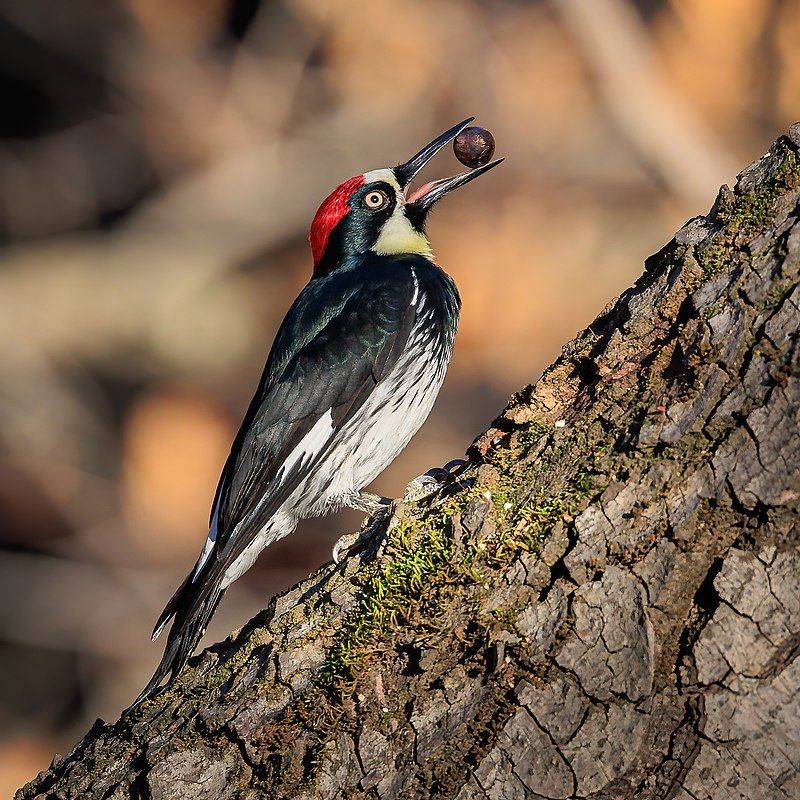
The acorn woodpecker is an impressive bird found in western North America. It is a medium-sized woodpecker, measuring 21 cm in length and weighing an average of 85 g.
This woodpecker is easily distinguished by its bright red head, as well as its black and white spotted wings and back.
Additionally, the acorn woodpecker’s bill is long and chisel-shaped, helping them to break into trees for food. The acorn woodpecker is a social bird and lives in colonies of up to 30 individuals.
They are known for their unique behavior of storing food in holes they drill in trees. They line the holes with bark or resin and store up to thousands of acorns and other nuts in each hole.
They also store food in other places, such as fences or telephone poles. The acorn woodpecker is an important species in the western North American ecosystem, helping spread the seeds of acorns and other nuts.
This helps to regenerate trees and other plants and keep the balance of the environment in check.
They are also a great food source for other animals, such as the Stellar’s jay, known to steal acorns from the woodpecker’s storehouse. In conclusion, the acorn woodpecker is an impressive species with a unique lifestyle.
It is a medium-sized woodpecker easily recognized by its bright red head and black and white spotted wings. This species plays an important role in the western North American ecosystem, helping to spread the seeds of various nuts and providing food for other animals.
| Kingdom | Animalia |
| Phylum | Chordata |
| Class | Aves |
| Order | Piciformes |
| Family | Picidae |
| Genus | Melanerpes |
| Species | M. formicivorus |
9. Neotropic Cormorant
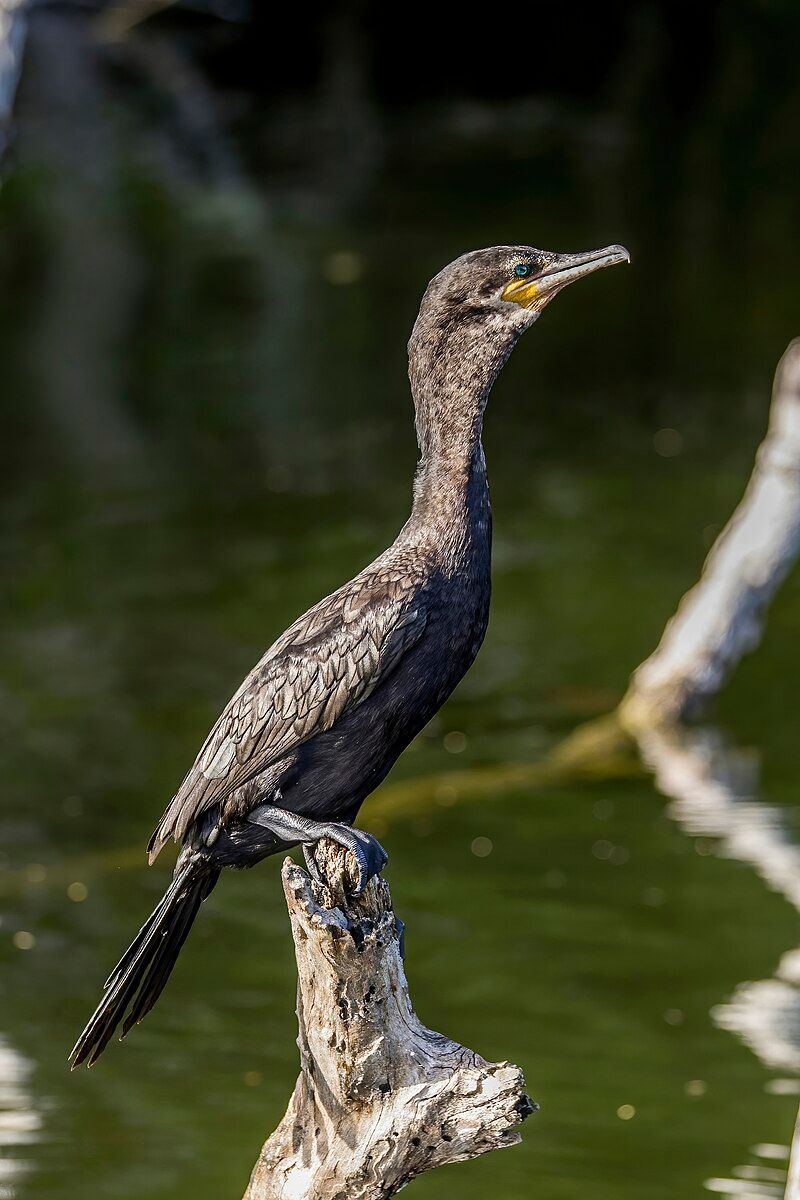
The Neotropic Cormorant, also known as the Olivaceous Cormorant, is a medium-sized bird that is native to the tropics and subtropics of the Americas. It is found from the middle Rio Grande in North America down to the Gulf Coast and California.
The Neotropic Cormorant typically lives near bodies of water, such as lakes, ponds, rivers, and the ocean.
It is typically seen foraging for food in these areas, diving in the water to catch fish, crustaceans, and other aquatic creatures. The Neotropic Cormorant is a distinct species from other cormorants, as it is smaller and has a different coloration.
Its plumage is mainly brown and black, with a white throat and yellowish bill. This species can also be identified by its small size, typically between twenty-four and thirty-six inches long.
The Neotropic Cormorant is an important species for aquatic ecosystems, as it helps to keep the water clean by consuming large numbers of fish and other aquatic creatures.
It is also an important species for birders, as its presence provides a great opportunity for observation and photography.
| Kingdom | Animalia |
| Phylum | Chordata |
| Class | Aves |
| Order | Suliformes |
| Family | Phalacrocoracidae |
| Genus | Nannopterum |
| Species | N. brasilianum |
10. Northern Mockingbird
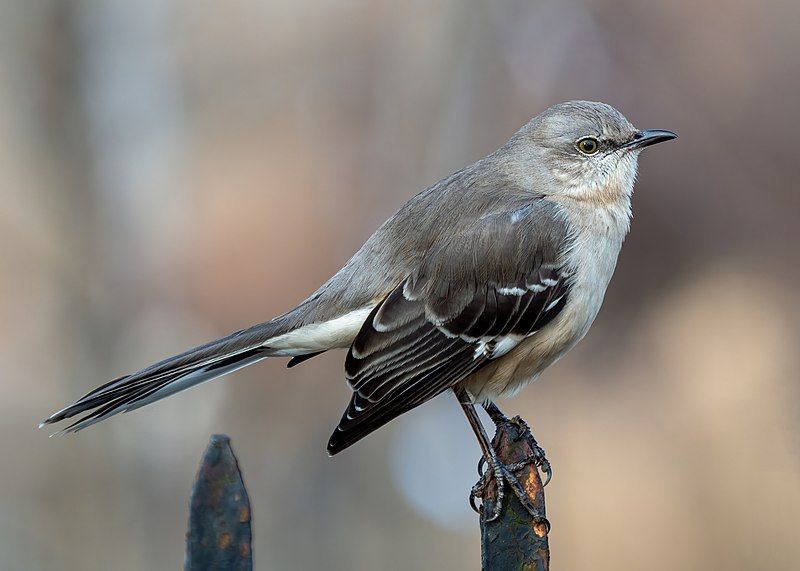
The northern mockingbird is a species of bird native to North America. It is a permanent resident in most of its range, though some birds may migrate south during severe weather.
The northern mockingbird has an impressive vocal range and can imitate the calls of many other birds, giving it its common name. It is a fairly adaptable bird and can live in various habitats, from urban parks to agricultural fields.
However, this species is rarely seen in Europe and is not well known in that part of the world.
| Kingdom | Animalia |
| Phylum | Chordata |
| Class | Aves |
| Order | Passeriformes |
| Family | Mimidae |
| Genus | Mimus |
| Species | M. polyglottos |
11. Roseate Spoonbill
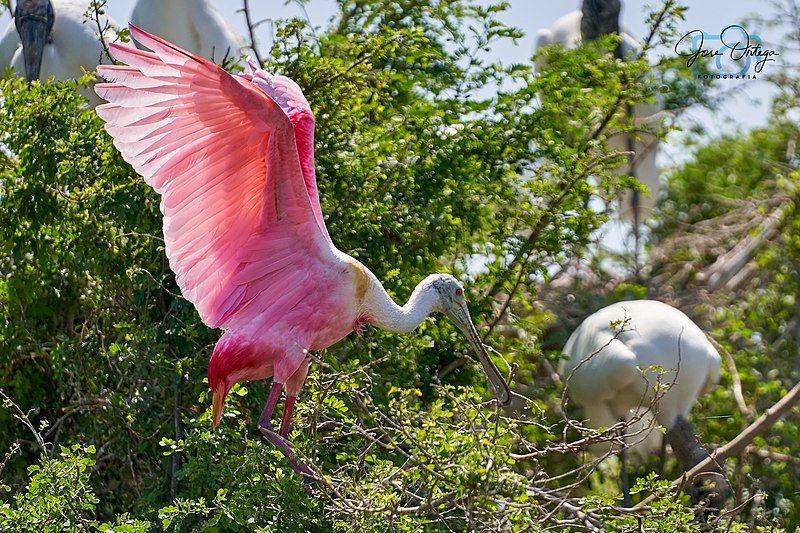
The roseate spoonbill is a type of wading bird found in both South and North America. It is part of the ibis and spoonbill family, Threskiornithidae, and is a resident breeder, meaning it typically stays in the same area to reproduce.
The bird is a unique pink color derived from its diet. This pink hue is created by carotenoid pigments, such as canthaxanthin, which are similar to the red pigment in the feathers of the American flamingo.
Spoonbills are known to be gregarious, meaning they typically interact and form large groups, making them a popular sight to see in many areas.
| Kingdom | Animalia |
| Phylum | Chordata |
| Class | Aves |
| Order | Pelecaniformes |
| Family | Threskiornithidae |
| Genus | Platalea |
| Species | P. ajaja |
12. Allen’s Hummingbird
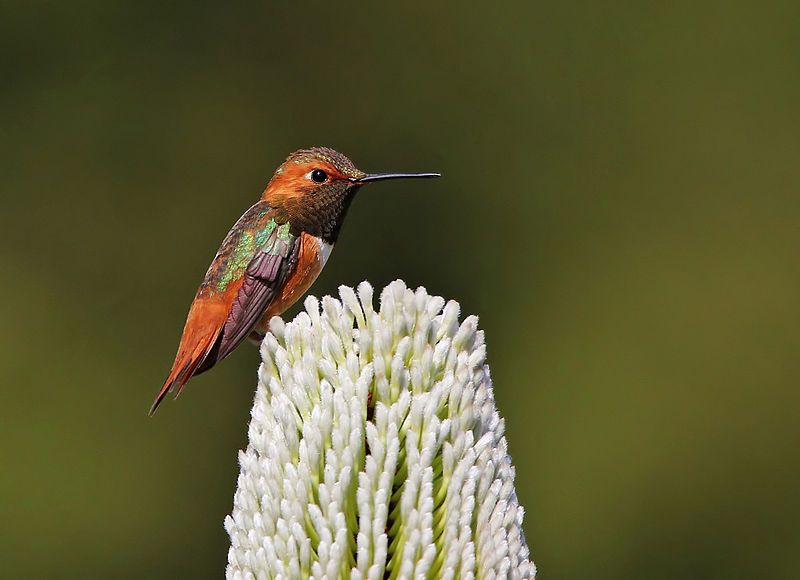
Allen’s hummingbird is a small bird native to the western United States. It is a member of the genus Selasphorus, which is composed of seven hummingbird species. It is a colorful bird with a green back and a white belly.
The male has a red throat, while the female has a white throat. The bird is most commonly found in open woodlands, meadows, and desert scrub. Its diet consists of nectar from flowers and small insects, which it consumes while hovering in the air.
Allen’s hummingbird is highly territorial regarding breeding and will vigorously defend its territory from other hummingbird species. It nests in trees or shrubs and builds its nest from plant fibers and spider webs.
The female lays two eggs, which hatch after about two weeks. The young birds fledge after about three weeks and are then left to fend for themselves.
| Kingdom | Animalia |
| Phylum | Chordata |
| Class | Aves |
| Clade | Strisores |
| Order | Apodiformes |
| Family | Trochilidae |
| Genus | Selasphorus |
| Species | S. sasin |
13. Hummingbirds
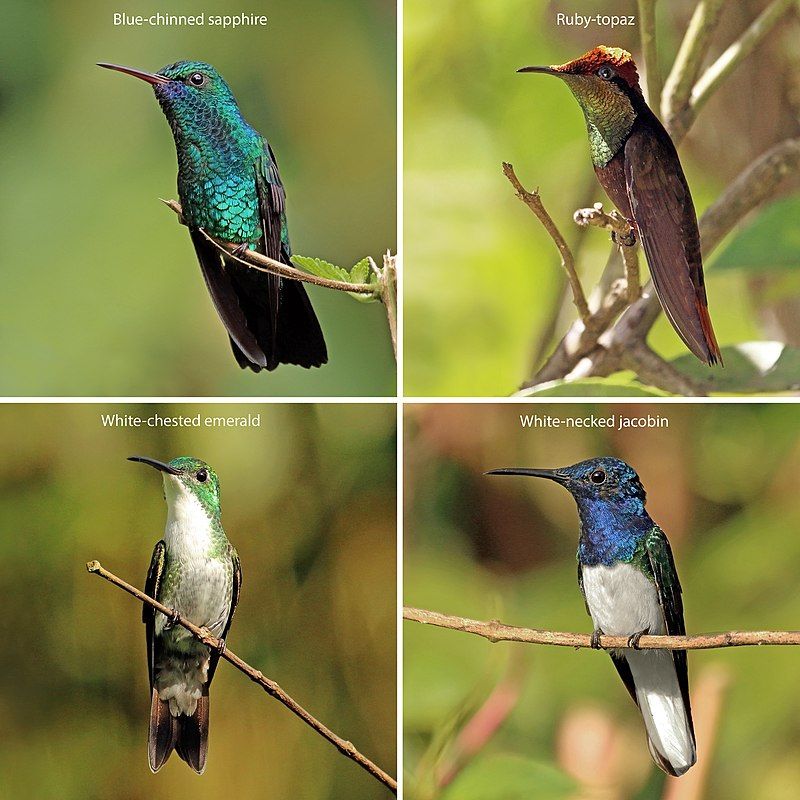
Hummingbirds are a fascinating species of bird that are native to the Americas. They are part of the Trochilidae biological family, with an estimated 366 species and 113 genera of hummingbirds.
They can be found throughout the Americas, from Alaska to Tierra del Fuego. However, most hummingbird species are concentrated in Central and South America.
Hummingbirds are renowned for their bright and iridescent plumage, as well as their impressive flying abilities. They can hover in midair and fly backward, making them truly unique birds.
Hummingbirds rely heavily on flowers for nectar, their main food source. They are also important pollinators; they transfer pollen from flower to flower while feeding. This helps to ensure the growth and reproduction of many plant species.
| Kingdom | Animalia |
| Phylum | Chordata |
| Class | Aves |
| Clade | Strisores |
| Order | Apodiformes |
| Family | Trochilidae |
14. Green-Tailed Towhee
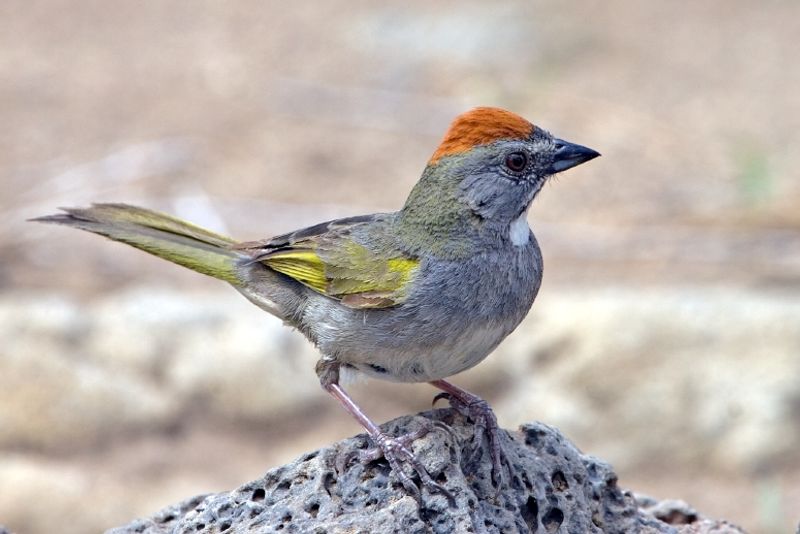
The green-tailed towhee is a bird native to the United States and is part of the sparrow family Passerellidae. It is the smallest species of towhee, yet still larger than many other birds in this family.
During the breeding season, the green-tailed towhee can be found throughout most interior Western United States. They migrate to Mexico and the southern parts of the Southwestern United States in winter.
This species can be distinguished from other towhees by its unique green tail. The green-tailed towhee spends most of its time on the ground, foraging for food, and it can often be found in chaparral and other shrubland habitats.
It is a fairly common bird, and its population is stable.
| Kingdom | Animalia |
| Phylum | Chordata |
| Class | Aves |
| Order | Passeriformes |
| Family | Passerellidae |
| Genus | Pipilo |
| Species | P. chlorurus |
15. Anna’s Hummingbird
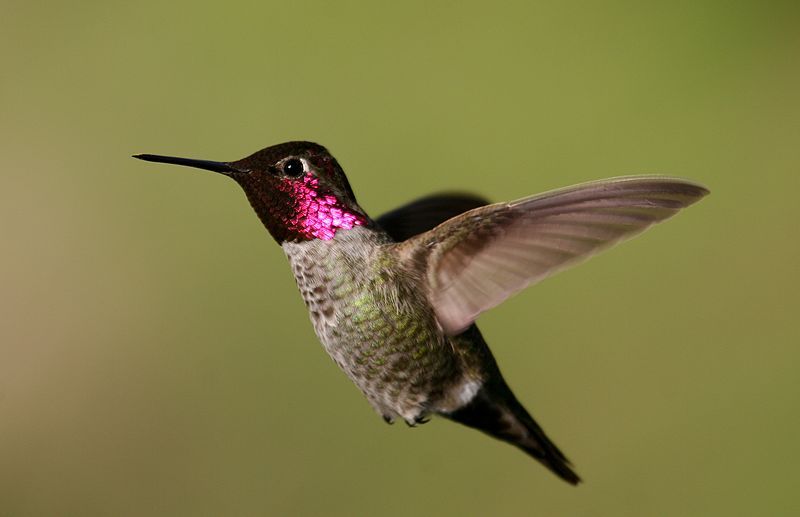
Anna’s hummingbird is a species of bird in the family Trochilidae, a group of small, colorful birds known for their ability to hover and fly quickly.
It is found in the western United States and Canada coastal regions and is named after Anna Masséna, Duchess of Rivoli.
In the early 1900s, Anna’s hummingbirds were only found in northern Baja California and southern California. Still, they have since expanded their range to the rest of the western United States and Canada.
They are medium-sized birds, with males ranging from about 3.5 to 4.5 inches long and females slightly smaller. They are easily recognizable by their vibrant metallic green and pink plumage and white streaks on the sides of their heads.
Anna’s hummingbirds feed on nectar from flowers, small insects, and spiders. They build their nests in shrubs or trees, using plant fibers, moss, and lichen to construct a cup-shaped nest.
They are territorial and will aggressively defend their nesting areas from other birds. In recent years, Anna’s hummingbirds have become popular backyard birds in the western United States.
They are attracted to feeders filled with sugar and water, and will often return to the same feeder if it is kept filled. As a result, they are a common sight in gardens and parks throughout the region.
| Kingdom | Animalia |
| Phylum | Chordata |
| Class | Aves |
| Clade | Strisores |
| Order | Apodiformes |
| Family | Trochilidae |
| Genus | Calypte |
| Species | C. anna |
16. Lesser Goldfinch
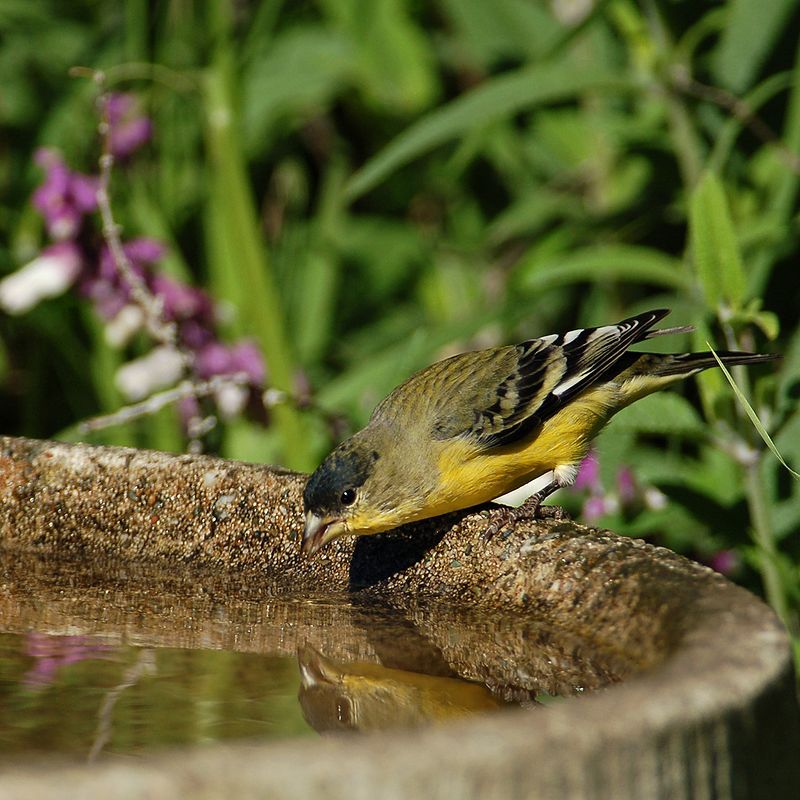
The lesser goldfinch is a small species of songbird native to the Americas. It is one of three species in the New World goldfinch clade, part of the Spinus genus. The other two species in the clade are the American goldfinch and Lawrence’s goldfinch.
The males of all three species are distinguished by their black foreheads, which the female birds lack. This trait is unique to the New World goldfinch clade and is not found among other species.
The lesser goldfinch is a popular bird among birdwatchers due to its small size and bright colors. It is known for its cheerful song and can often be found in gardens and woodlands.
| Kingdom | Animalia |
| Phylum | Chordata |
| Class | Aves |
| Order | Passeriformes |
| Family | Fringillidae |
| Genus | Spinus |
| Species | S. psaltria |
17. American White Pelican

The American white pelican is a large bird native to North America. It is part of the order Pelecaniformes, which consists of birds such as pelicans, herons, egrets, and cormorants. The white pelican typically breeds in interior North America, in places like lakes and rivers.
During winter, it migrates south and to the coasts, sometimes traveling as far as Costa Rica. The white pelican is well known for its ability to soar, which lets it cover vast distances during its migrations.
Its wingspan can reach up to 9.8 feet, making it one of the largest birds in North America. The white pelican is a majestic and graceful creature; its presence is a sight to behold.
| Kingdom | Animalia |
| Phylum | Chordata |
| Class | Aves |
| Order | Pelecaniformes |
| Family | Pelecanidae |
| Genus | Pelecanus |
| Species | P. erythrorhynchos |
18. Barn Owl
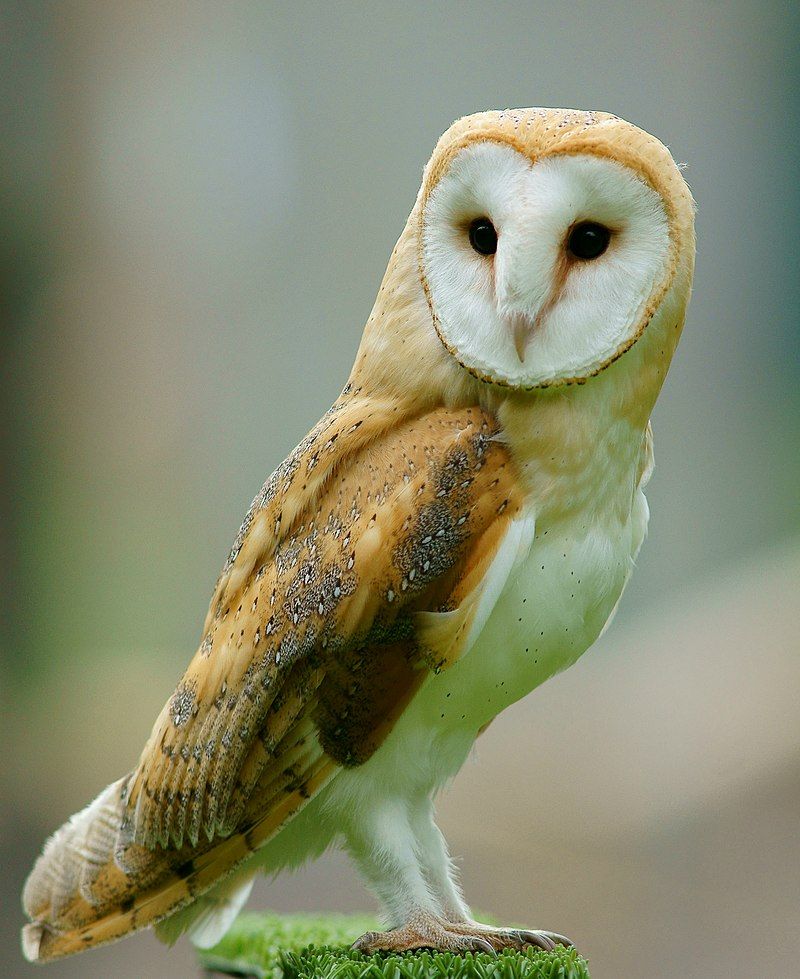
The barn owl is an incredibly adaptable bird species that is found in a wide variety of habitats. It is one of the most widespread bird species in the world, living in all regions except for the polar and desert areas, most of Indonesia, and some Pacific Islands.
Its range is spread across all continents, from North and South America to Europe, Africa, and Asia south of the Himalayas. The barn owl is a nocturnal bird of prey that feeds mainly on small mammals.
It has a heart-shaped facial disc that helps it to detect its prey in the dark. Its color is usually greyish brown on its back with white underparts.
The barn owl is a sociable bird, often living in pairs or small family groups. The barn owl is an important part of the ecosystem, helping to keep small mammal populations in check.
Despite its widespread range, its population is declining due to habitat destruction, hunting, and other human activities. Conservation efforts are underway to protect the barn owl and its habitat.
| Kingdom | Animalia |
| Phylum | Chordata |
| Class | Aves |
| Order | Strigiformes |
| Family | Tytonidae |
| Genus | Tyto |
| Species | T. alba |
19. Yellow-Billed Cuckoo
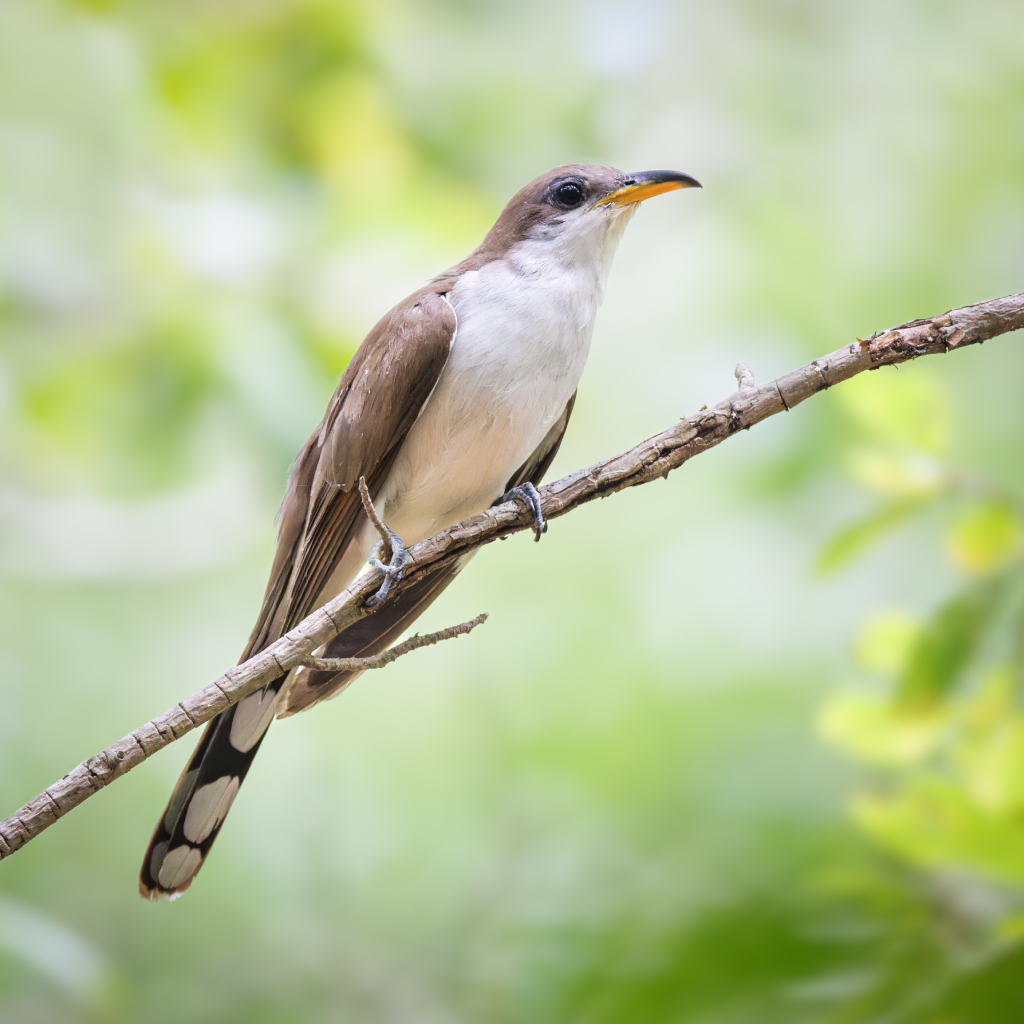
The yellow-billed cuckoo is found in the southern parts of the United States. It has earned two common folk names in these areas, “Rain Crow” and “Storm Crow.”
These names likely come from the bird’s habit of calling out on hot days followed by rain or thunderstorms. This behavior has led to the belief that the cuckoo can predict the weather.
Despite this, the exact cause of its behavior is not yet fully understood. The cuckoo may respond to atmospheric changes associated with the arrival of rain or thunderstorms.
It is also possible that the bird is reacting to other cues, such as changes in barometric pressure or humidity. Whatever the cause, the cuckoo’s behavior has earned it an important place in the folklore of the southern United States.
| Kingdom | Animalia |
| Phylum | Chordata |
| Class | Aves |
| Order | Cuculiformes |
| Family | Cuculidae |
| Genus | Coccyzus |
| Species | C. americanus |
20. Inca Dove
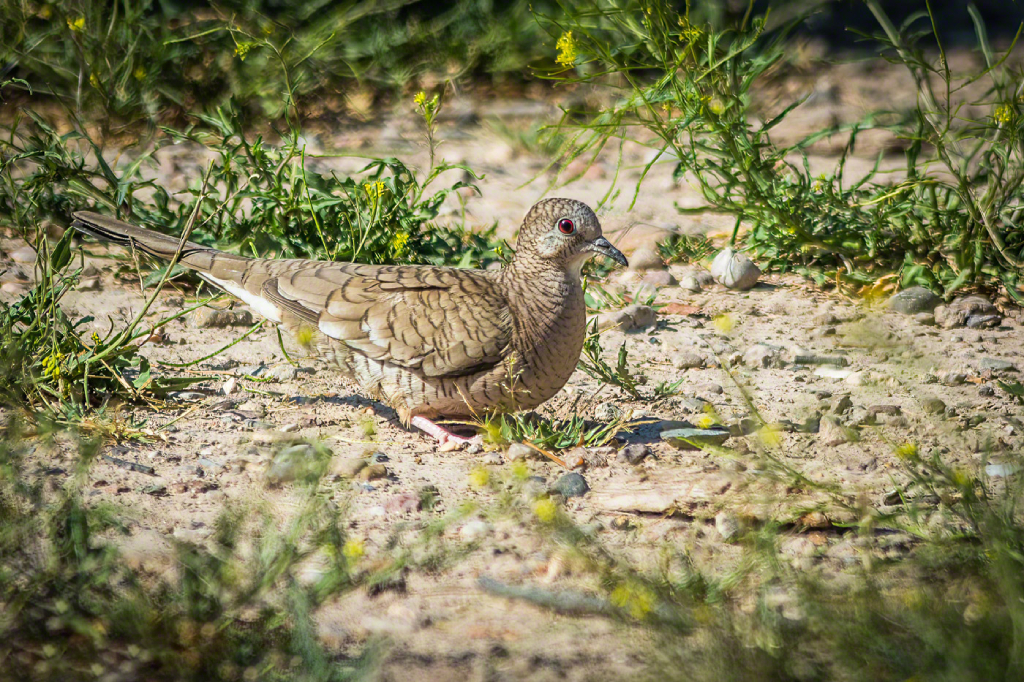
The Inca dove, also known as the Mexican dove, is a small bird native to the New World. This dove species was first documented in 1847 by French surgeon and naturalist René Lesson.
The Inca dove is a fairly small bird, with a body length ranging from 16.5 to 23 cm and a weight of 30 to 58 g. Its wingspan is usually around 28.5 cm, although it may reach 32 cm when fully extended.
It has a distinctive white patch on its wings and a grey and brown coloration, distinguishing it from other doves. Its habitat ranges from tropical forest to open country, and it feeds on seeds and insects.
It is a monogamous species, and its nest is typically built in a tree or bush.
| Kingdom | Animalia |
| Phylum | Chordata |
| Class | Aves |
| Order | Columbiformes |
| Family | Columbidae |
| Genus | Columbina |
| Species | C. inca |
21. Dark-Eyed Junco
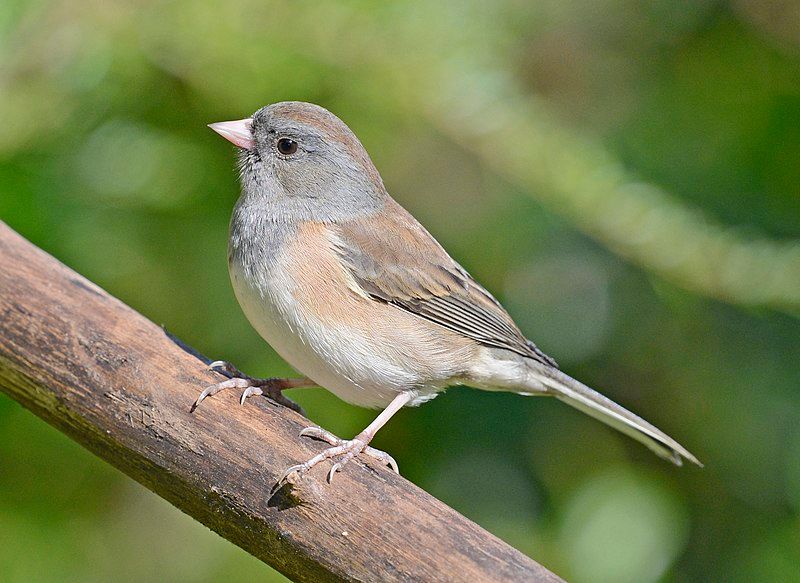
The dark-eyed junco is a bird species from the junco family, a group of small, grayish birds found in New World regions. This species is found across much of temperate North America and can even range from the Arctic during summer.
It is quite variable, much like the fox sparrow, and its systematics (the scientific study of the classification of organisms) are still not completely understood.
This could be because the junco family has a wide range of shapes, sizes, and colors, making it difficult to classify them accurately. The dark-eyed junco is a rather common bird seen in many areas of North America.
It is a small, grayish bird and has a dark eye. It can be found in various habitats, including open woodlands, grasslands, and shrublands. It feeds on various small insects and seeds and is an important part of the food chain.
The dark-eyed junco is an important species in the temperate North American ecosystem, and its conservation is important to maintain the balance of the region’s habitats and food webs.
| Kingdom | Animalia |
| Phylum | Chordata |
| Class | Aves |
| Order | Passeriformes |
| Family | Passerellidae |
| Genus | Junco |
| Species | J. hyemalis |
22. Spotted Towhee
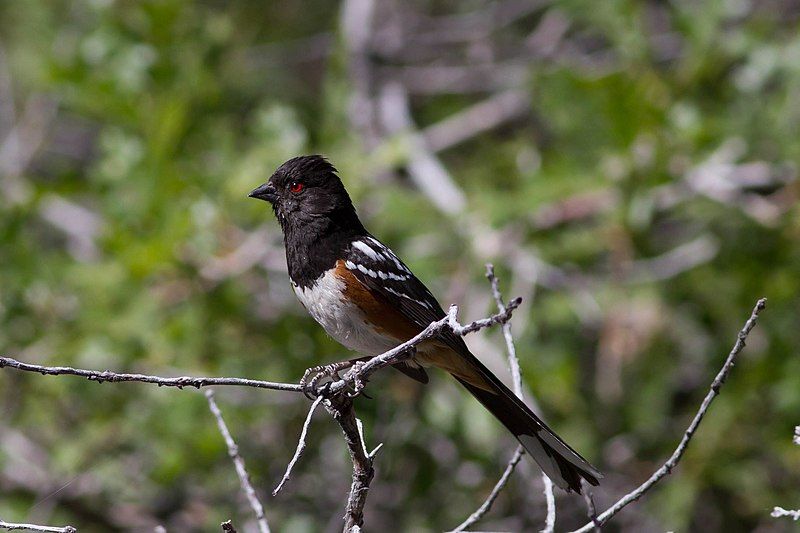
The spotted towhee is a large New World sparrow native to North America. It has been recognized as a distinct species since 1995, though before that, it was grouped with the eastern towhee as a single species, known as the rufous-sided towhee.
This distinction is significant in terms of the taxonomy of the towhees, as it helps to clarify the evolutionary history and relationships of these two species. An outdated name, the Oregon towhee, also refers to the spotted towhee.
This name is now used less commonly, as it has been replaced by the more accurate name of the spotted towhee. The debate surrounding the taxonomy of the towhees is ongoing as researchers continue to explore the evolutionary history and relationships of these species.
| Kingdom | Animalia |
| Phylum | Chordata |
| Class | Aves |
| Order | Passeriformes |
| Family | Passerellidae |
| Genus | Pipilo |
| Species | P. maculatus |
23. Ash-throated flycatcher
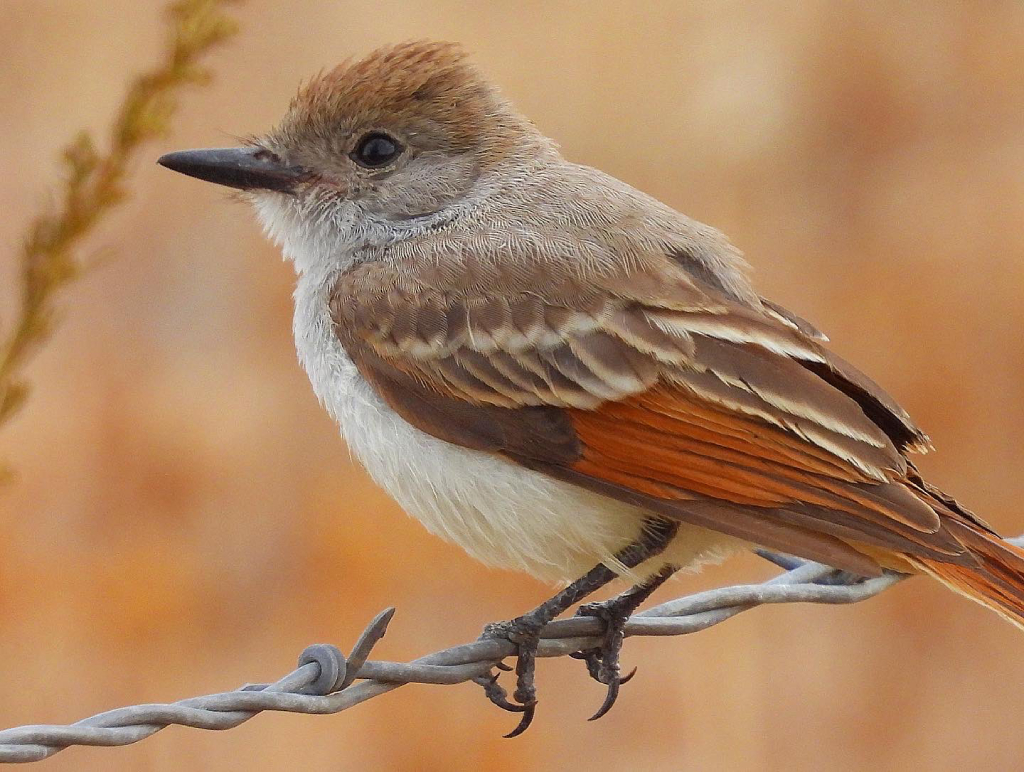
The ash-throated flycatcher is a species of bird belonging to the family Tyrannidae, commonly known as the tyrant flycatcher. This bird species is a passerine, meaning it is a perching bird, distinguished by its short, stout bill.
The ash-throated flycatcher is typically found in the deserts and shrublands of the southwestern United States and northwestern Mexico. The ash-throated flycatcher is a medium-sized bird with a grayish-brown back and a pale white or yellowish breast.
Its tail is long and rounded, and its wings are short and rounded. Its head is grayish-white, and its throat is a distinctive ash-gray color, where the bird gets its name.
The ash-throated flycatcher is also characterized by its loud, harsh, three-note call, starting with a short, sharp note, followed by two longer notes. This bird is a solitary species, and it does not usually flock with other birds.
It is mainly insectivorous, feeding small insects such as beetles, grasshoppers, and caterpillars.
The ash-throated flycatcher is migratory and spends the winter months in Mexico and Central America. At the same time, it returns to its breeding grounds in the southwestern United States in the spring.
The nests are usually built in low shrubs or trees, and the female lays three to four eggs. The ash-throated flycatcher is a common bird, and its population is considered to be stable.
However, its population is threatened by the destruction of its habitat due to human activities such as logging and urban development. Conservation measures are in place to protect the species and its habitat.
| Kingdom | Animalia |
| Phylum | Chordata |
| Class | Aves |
| Order | Passeriformes |
| Family | Tyrannidae |
| Genus | Myiarchus |
| Species | M. cinerascens |
Conclusion
Birds in San Gabriel are an essential part of the local ecosystem. They provide food for other animals, disperse seeds, control insect populations, and offer aesthetic beauty to the local area.
With proper conservation efforts, these birds can continue to be enjoyed by locals and visitors for many years.